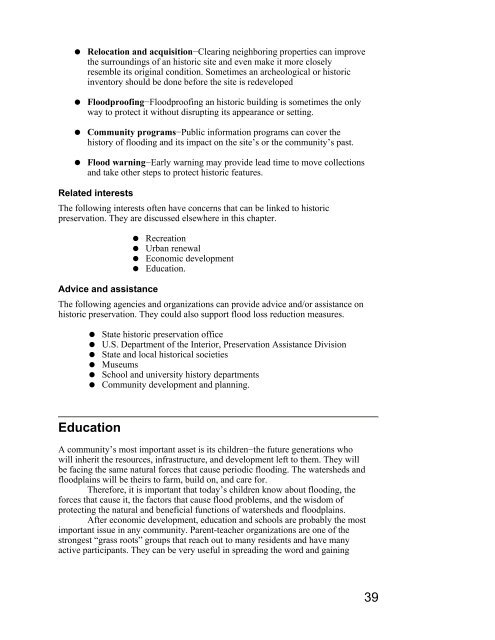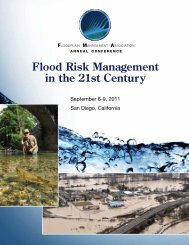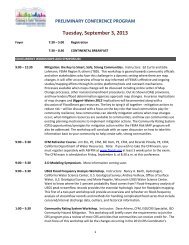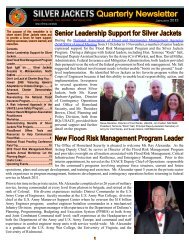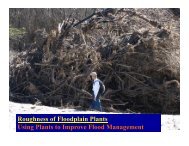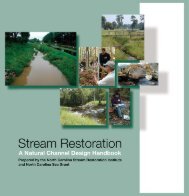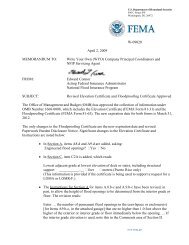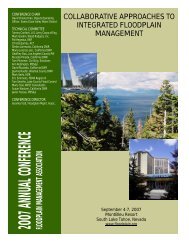Using Multi-Objective Management to Reduce Flood Losses in Your
Using Multi-Objective Management to Reduce Flood Losses in Your
Using Multi-Objective Management to Reduce Flood Losses in Your
You also want an ePaper? Increase the reach of your titles
YUMPU automatically turns print PDFs into web optimized ePapers that Google loves.
Relocation and acquisition−Clear<strong>in</strong>g neighbor<strong>in</strong>g properties can improve<br />
the surround<strong>in</strong>gs of an his<strong>to</strong>ric site and even make it more closely<br />
resemble its orig<strong>in</strong>al condition. Sometimes an archeological or his<strong>to</strong>ric<br />
<strong>in</strong>ven<strong>to</strong>ry should be done before the site is redeveloped<br />
<strong>Flood</strong>proof<strong>in</strong>g−<strong>Flood</strong>proof<strong>in</strong>g an his<strong>to</strong>ric build<strong>in</strong>g is sometimes the only<br />
way <strong>to</strong> protect it without disrupt<strong>in</strong>g its appearance or sett<strong>in</strong>g.<br />
Community programs−Public <strong>in</strong>formation programs can cover the<br />
his<strong>to</strong>ry of flood<strong>in</strong>g and its impact on the site’s or the community’s past.<br />
<strong>Flood</strong> warn<strong>in</strong>g−Early warn<strong>in</strong>g may provide lead time <strong>to</strong> move collections<br />
and take other steps <strong>to</strong> protect his<strong>to</strong>ric features.<br />
Related <strong>in</strong>terests<br />
The follow<strong>in</strong>g <strong>in</strong>terests often have concerns that can be l<strong>in</strong>ked <strong>to</strong> his<strong>to</strong>ric<br />
preservation. They are discussed elsewhere <strong>in</strong> this chapter.<br />
Recreation<br />
Urban renewal<br />
Economic development<br />
Education.<br />
Advice and assistance<br />
The follow<strong>in</strong>g agencies and organizations can provide advice and/or assistance on<br />
his<strong>to</strong>ric preservation. They could also support flood loss reduction measures.<br />
State his<strong>to</strong>ric preservation office<br />
U.S. Department of the Interior, Preservation Assistance Division<br />
State and local his<strong>to</strong>rical societies<br />
Museums<br />
School and university his<strong>to</strong>ry departments<br />
Community development and plann<strong>in</strong>g.<br />
Education<br />
A community’s most important asset is its children−the future generations who<br />
will <strong>in</strong>herit the resources, <strong>in</strong>frastructure, and development left <strong>to</strong> them. They will<br />
be fac<strong>in</strong>g the same natural forces that cause periodic flood<strong>in</strong>g. The watersheds and<br />
floodpla<strong>in</strong>s will be theirs <strong>to</strong> farm, build on, and care for.<br />
Therefore, it is important that <strong>to</strong>day’s children know about flood<strong>in</strong>g, the<br />
forces that cause it, the fac<strong>to</strong>rs that cause flood problems, and the wisdom of<br />
protect<strong>in</strong>g the natural and beneficial functions of watersheds and floodpla<strong>in</strong>s.<br />
After economic development, education and schools are probably the most<br />
important issue <strong>in</strong> any community. Parent-teacher organizations are one of the<br />
strongest “grass roots” groups that reach out <strong>to</strong> many residents and have many<br />
active participants. They can be very useful <strong>in</strong> spread<strong>in</strong>g the word and ga<strong>in</strong><strong>in</strong>g<br />
39


